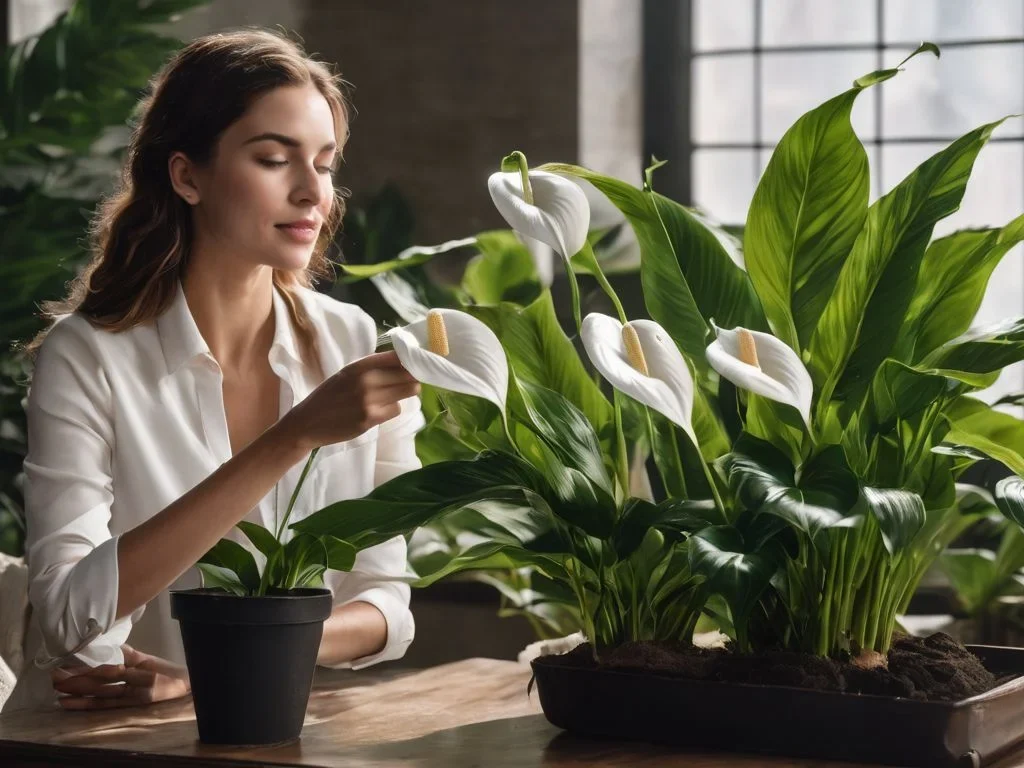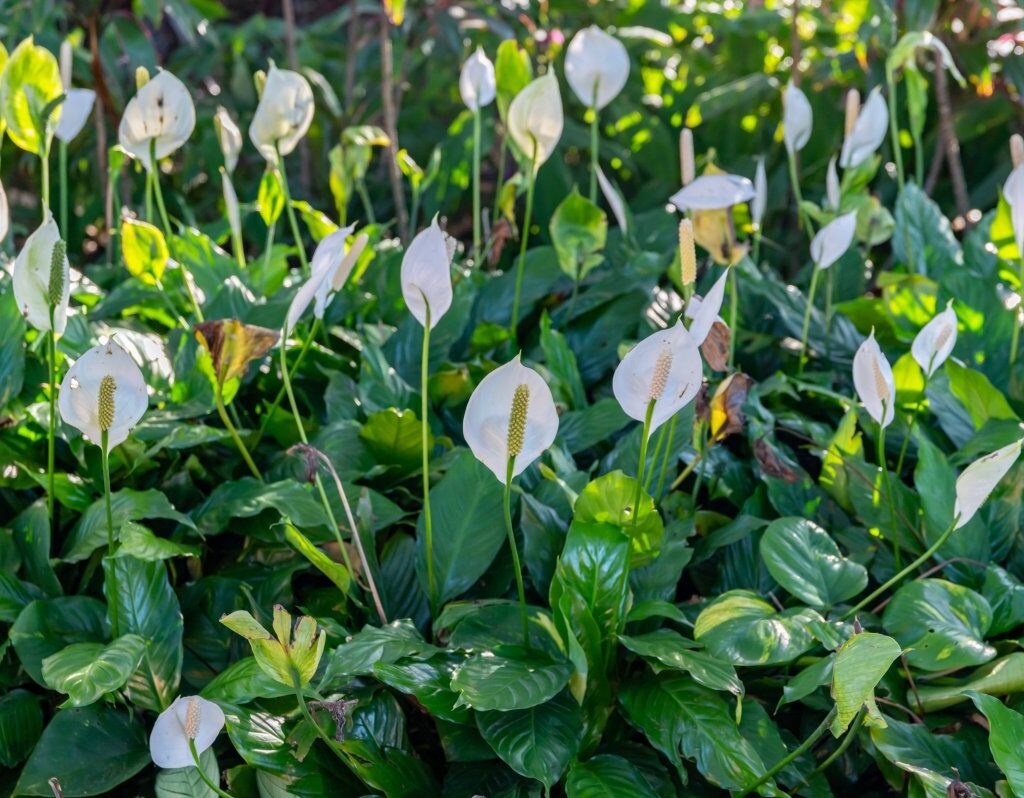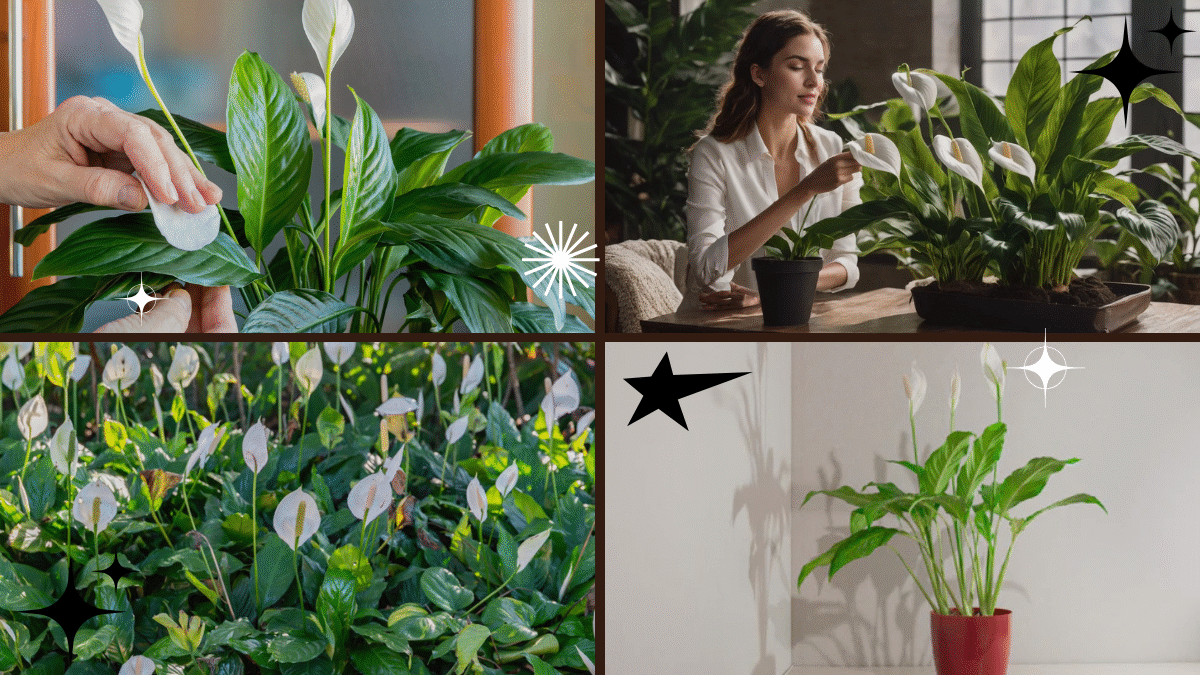If you’re looking for a plant that brings beauty, calm, and clean air into your home, look no further than the peace lily. With its elegant white blooms and lush green leaves, the peace lily (Spathiphyllum) has become a favorite among houseplant lovers for its beauty and easy care. Beyond aesthetics, it’s also known for purifying indoor air and adding a serene, spa-like feel to any room.
In this detailed guide, we’ll explore how to take care of a peace lily plant, from choosing the right spot to watering, feeding, repotting, and solving common problems. Whether you’re a seasoned plant parent or a beginner hoping to add a touch of tranquility to your space, this article covers everything you need to know.

Why Choose a Peace Lily?
Peace lilies aren’t just beautiful — they’re also one of the best houseplants for indoor air purification, according to NASA’s Clean Air Study. They help remove toxins like formaldehyde, benzene, and carbon monoxide from the air while gracing your space with elegant blooms and lush foliage.
Plus, peace lilies symbolize peace, prosperity, and healing, making them thoughtful gifts for homes and offices.
Key benefits of peace lilies:
- Elegant appearance
- Low maintenance
- Air-purifying qualities
- Symbolic of peace and renewal

Choosing the Right Location
Peace lilies thrive in bright, indirect light. While they can tolerate lower light conditions, too little light can lead to fewer blooms and leggy growth.
Ideal spot:
- Near a north or east-facing window
- Away from direct afternoon sun (which can scorch leaves)
- In a warm room with temperatures between 65°F and 80°F (18°C to 27°C)
Avoid placing your peace lily near drafts, heating vents, or air conditioners, as sudden temperature changes can stress the plant.

How to Water a Peace Lily
One of the most common mistakes plant owners make with peace lilies is overwatering. These plants prefer consistently moist but not soggy soil.
Watering tips:
- Water when the top inch of soil feels dry to the touch.
- Use room-temperature, filtered, or distilled water if possible. Peace lilies are sensitive to fluoride and chlorine in tap water, which can cause leaf tips to brown.
- Reduce watering in the winter when growth slows.
- Peace lilies will dramatically droop when thirsty — it’s their natural way of telling you they need a drink. Thankfully, they usually perk back up quickly after watering.
Pro Tip: Empty the saucer after watering to prevent root rot.

Best Soil for Peace Lilies
Peace lilies prefer a well-draining, loose, and rich soil mix. A high-quality indoor potting mix blended with a bit of perlite or orchid bark works well.
DIY mix suggestion:
- 2 parts all-purpose potting soil
- 1 part perlite
- 1 part orchid bark or coconut coir
This combination ensures good drainage while retaining enough moisture for healthy growth.
Ideal Light Conditions
While peace lilies are known for being adaptable to various light conditions, they truly thrive in bright, indirect light. Too much direct sunlight can scorch their leaves, causing brown patches, while too little light reduces flowering.
Signs your peace lily needs more light:
- No blooms for months
- Leggy, pale leaves
- Slow growth
If your plant isn’t flowering, try moving it to a brighter, filtered spot and be patient — peace lilies typically bloom twice a year, with flowers lasting several weeks.
Fertilizing Your Peace Lily
Peace lilies aren’t heavy feeders but appreciate occasional nutrients to stay lush and produce blooms.
Fertilizing schedule:
- Use a balanced, water-soluble houseplant fertilizer diluted to half strength.
- Fertilize once a month during the growing season (spring and summer).
- Avoid fertilizing in the fall and winter when the plant’s growth slows.
Over-fertilizing can cause salt build-up in the soil, leading to brown leaf tips. If you notice this, flush the soil with water to remove excess salts.
Repotting a Peace Lily
Repotting is essential every 1-2 years or when your peace lily outgrows its current pot. Signs it’s time to repot include:
- Roots growing out of the drainage holes
- Plant drying out quickly after watering
- Stunted growth
How to repot:
- Choose a pot 1-2 inches larger in diameter with drainage holes.
- Gently remove the plant from its current container.
- Loosen any compacted roots.
- Place the plant in fresh, well-draining soil.
- Water thoroughly and let it drain.
Pro Tip: Repot in spring when the plant is actively growing.
Common Peace Lily Problems and Solutions
Despite being low-maintenance, peace lilies occasionally encounter issues. Here’s how to troubleshoot common problems:
Brown Leaf Tips
Cause: Over-fertilizing, fluoride in water, or low humidity
Solution: Trim damaged tips, use distilled water, and mist leaves to boost humidity.
Drooping Leaves
Cause: Underwatering or overwatering
Solution: Check soil moisture and adjust watering accordingly.
No Flowers
Cause: Insufficient light or over-fertilizing
Solution: Move to a brighter spot and avoid excessive fertilizer.
Yellowing Leaves
Cause: Overwatering or old age
Solution: Remove yellow leaves and check soil drainage.
How to Encourage Blooming
Peace lilies bloom best with consistent care and bright, indirect light. If yours is reluctant to flower:
- Ensure it receives adequate light without direct sun.
- Maintain steady temperatures between 65°F-80°F.
- Avoid over-fertilizing.
- Repot if root-bound.
Patience is key — peace lilies generally bloom twice a year, in spring and fall.
Humidity and Temperature Requirements
Peace lilies love humidity. In dry indoor environments, especially in winter, increase humidity by:
- Misting leaves regularly
- Placing the plant on a tray of pebbles and water
- Grouping with other houseplants
Maintain room temperatures between 65°F and 80°F and keep away from cold drafts and heat vents.
Cleaning and Maintenance
Dust can accumulate on broad peace lily leaves, affecting their ability to photosynthesize.
Clean leaves every few weeks:
- Wipe gently with a damp, soft cloth.
- Alternatively, give the plant a lukewarm shower to rinse off dust.
Propagating a Peace Lily
Peace lilies can be propagated through division when repotting:
- Remove the plant from its pot.
- Gently separate clumps of roots and stems.
- Pot divisions into separate containers with fresh soil.
- Water thoroughly.
This is a great way to multiply your plant collection or share with friends!
Final Thoughts
Caring for a peace lily is an easy, rewarding way to bring serenity, greenery, and purified air into your living space. With minimal effort — providing the right light, consistent watering, occasional feeding, and attention to its needs — you’ll enjoy a thriving, elegant plant that adds natural beauty and peaceful vibes to your home.
Whether placed on a desk, shelf, or tabletop, a peace lily is more than just décor — it’s a living symbol of calm and renewal.





Leave A Comment